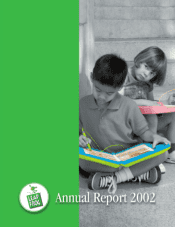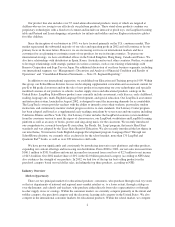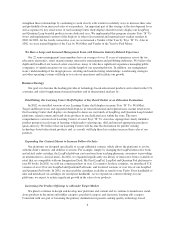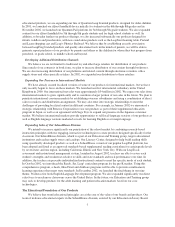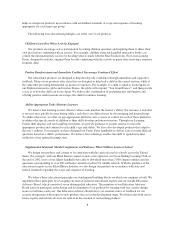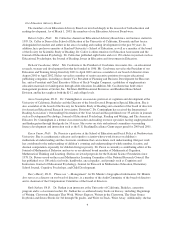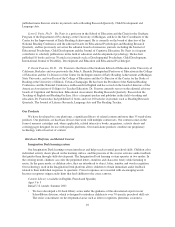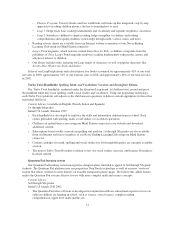LeapFrog 2002 Annual Report Download - page 7
Download and view the complete annual report
Please find page 7 of the 2002 LeapFrog annual report below. You can navigate through the pages in the report by either clicking on the pages listed below, or by using the keyword search tool below to find specific information within the annual report.Our product line also includes over 35 stand-alone educational products, many of which are targeted at
children who are too young to use effectively our platform products. These stand-alone products combine our
proprietary technologies with a fixed set of content and include our interactive plush toys, our LeapStart learning
table and Pretend and Learn shopping cart products for infants and toddlers and our Explorer interactive globes
for older children.
Since the inception of our business in 1995, we have focused primarily on the U.S. consumer market. This
market represented the substantial majority of our sales and operating profit in 2002 and will continue to be our
primary focus in the near future. However, we are increasing our focus on international markets and have
customized or are planning to customize many of our products for use in foreign countries. To pursue our
international strategy, we have established offices in the United Kingdom, Hong Kong, Canada and France. We
also have relationships with distributors in Spain, Korea, Australia and several other countries. Further, we intend
to leverage relationships with strategic partners in various countries, such as our existing relationships with
Benesse Corporation and Sega Toys in Japan. For additional discussion of our three business segments, including
our international segment, see “Management’s Discussion and Analysis of Financial Condition and Results of
Operations” and “Consolidated Financial Statements — Note 22. Segment Reporting.”
In addition to our international expansion, we established our Education and Training group in 1999. Within
this group, our SchoolHouse division focuses on developing supplemental curriculum and assessment content for
pre-K to 8th grade classrooms and on the sale of new products incorporating our core technologies and specially
modified versions of our products to schools, teacher supply stores and educational products catalogs in the
United States. LeapFrog SchoolHouse product areas currently include assessment, early literacy, early childhood,
reading, language arts, math, English Language Development, and special education. Our LeapTrack assessment
and instruction system, launched in August 2002, is designed to meet the increasing demands for accountability.
The LeapTrack system provides teachers with the ability to instantly assess their students, personalize student
instruction, and continuously monitor student progress relative to state standards. Our Literacy Center program
has been adopted and listed as a supplemental early reading curriculum by seven states and one region, including
California, Illinois and New York City. Our Literacy Center includes the LeapPad classroom system modified
from the consumer version to meet the rigors of classroom use, our LeapDesk workstation and LeapMat learning
platform as well as an array of books, posters and sing-along music for the classroom. We recently introduced
our comprehensive, research-based pre-K curriculum, the Ready, Set, Leap! program, that meets Head Start
standards and was adopted by the Texas State Board of Education. We also recently introduced the last theme in
our nine theme, 36 interactive book English Language Development program, Language First! Through our
SchoolHouse division, we currently offer, exclusively for the school market, more than 170 LeapPad and
Quantum Pad™books, as well as over 290 interactive skill cards.
We have grown significantly and consistently by introducing innovative new platforms and other products,
expanding our content offerings and increasing our distribution. From 2000 to 2002, our net sales increased from
$160.1 million to $531.8 million and our net income/loss increased from a net loss of $2.3 million to net income
of $43.4 million. Our 2002 market share of 20% in the $2.0 billion preschool category (according to NPD data)
also evidences the strength of our products. In 2002, we had five of the top ten best-selling products in the
preschool category based on total dollar sales, including the top three products, according to NPD.
Industry Overview
Market Opportunity
There are two principal markets for educational products: consumers, who purchase through retail toy stores
or the toy departments of national and regional mass-market retailers or, to a lesser extent, through catalogs or
over the Internet; and schools and teachers, who purchase either directly from sales representatives or through
teacher supply stores or catalogs. Within the consumer market, we currently compete primarily in the infant and
toddler category, the preschool category and the electronic learning aids category in the United States. We also
compete in the international consumer markets for educational products. Within the school market, we compete
2

